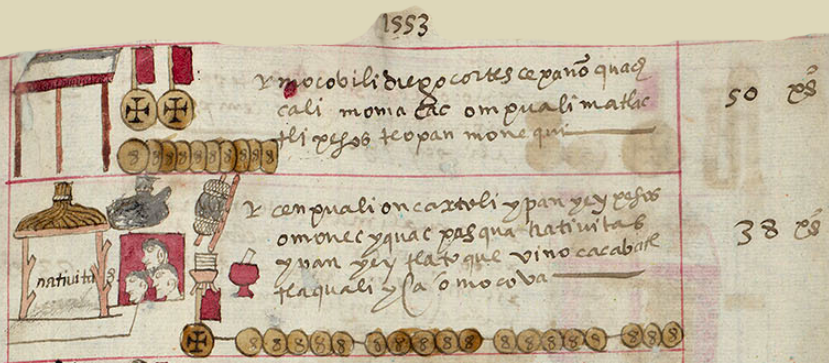pañocuachcalli (CST9)
This is painting of the simplex glyph for the term pañocuachcalli. The glyph shows a structure of three visible (presumably wooden) brown poles that hold up a gray, white, and red canopy. This is a term that is partly a loanword from Spanish (paño), but otherwise includes two Nahuatl words (cuachtli, cloth, and calli, structure).
Stephanie Wood
This pavilion with a canopy could have involved either a woolen or a cotton cloth, but here wool was more prevalent. The canopy was something the local Catholic church needed, and it cost 50 pesos. The high price suggests that the structure was large, probably for an outdoor event such as a fiesta. Prior to contact, Nahuas were accustomed to outdoor ceremonialism, and this continued after Spanish colonization with some alterations. For more on the Codex Sierra, see Kevin Terraciano’s study (2021).
Stephanie Wood
1550–1564
Jeff Haskett-Wood
tela, textiles, pabellones, toldos, arquitectura, iglesia

paño, cloth, can be woolen, especially where sheep are raised (a Spanish loan into Nahuatl), https://nahuatl.wired-humanities.org/content/pano-0
cuach(tli), a large piece of cloth, can be cotton, https://nahuatl.wired-humanities.org/content/cuachtli
cal(li), house, building, structure, https://nahuatl.wired-humanities.org/content/calli
pabellón
Stephanie Wood
Códice Sierra-Texupan, plate 9, page dated 1553. Origin: Santa Catalina Texupan, Mixteca Alta, State of Oaxaca. Kevin Terraciano has published an outstanding study of this manuscript (Codex Sierra, 2021), and in his book he refers to alphabetic and “pictorial” writing, not hieroglyphic writing. We are still counting some of the imagery from this source as hieroglyphic writing, but we are also including examples of “iconography” where the images verge on European style illustrations or scenes showing activities. We have this iconography category so that such images can be fruitfully compared with hieroglyphs. Hieroglyphic writing was evolving as a result of the influence of European illustrations, and even alphabetic writing impacted it.
https://bidilaf.buap.mx/objeto.xql?id=48281&busqueda=Texupan&action=sear...
The Biblioteca Digital Lafragua of the Biblioteca Histórica José María Lafragua in Puebla, Mexico, publishes this Códice Sierra-Texupan, 1550–1564 (62pp., 30.7 x 21.8 cm.), referring to it as being in the “Public Domain.” This image is published here under a Creative Commons license, asking that you cite the Biblioteca Digital Lafragua and this Visual Lexicon of Aztec Hieroglyphs.






